
The Dassault Étendard II was a French prototype fighter aircraft initially developed as a follow-on project to the Dassault Mystère series. It was presented to the French Air Force for evaluation but was rejected in favour of the Dassault Mirage III.

The Dornier Do 18 was a development of the Do 16 flying boat. It was developed for the Luftwaffe, but Luft Hansa received five aircraft and used these for tests between the Azores and the North American continent in 1936 and on their mail route over the South Atlantic from 1937 to 1939.

The Sukhoi Su-47 Berkut, also designated S-32 and S-37 during initial development, was an experimental supersonic jet fighter developed by the JSC Sukhoi Company. A distinguishing feature of the aircraft was its forward-swept wing that gave the aircraft excellent agility and maneuverability. While serial production of the type never materialized, the sole aircraft produced served as a technology demonstrator prototype for a number of advanced technologies later used in the 4.5 generation fighter Su-35 and current fifth-generation jet fighter Su-57.

The Ilyushin Il-6 was a Soviet long-range bomber developed from the Ilyushin Il-4 during 1942. Originally intended as a high-speed replacement for the Il-4, it was recast as a very long-range bomber with fuel-conserving diesel engines before production of the single prototype began in December 1942. Flight testing showed controllability issues when landing at high weights and the engines proved to be hard to start at low temperatures and were slow to respond to throttle movements. Further development was canceled in 1944.

The Savoia-Marchetti SM.81 Pipistrello was the first three-engine bomber/transport aircraft serving in the Italian Regia Aeronautica. When it appeared in 1935, it represented a real step ahead in Italian military aviation: it was fast, well armed and had a long range. It proved effective during the war with Ethiopia and the Spanish Civil War. Despite being too slow to remain competitive as a bomber in the later years of World War II, it was one of the most flexible, reliable and important aircraft of the Regia Aeronautica from 1935 to 1944, and adapted to second-line duties in a wide range of tasks.
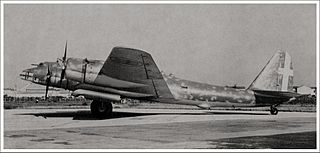
The Piaggio P.108 Bombardiere was an Italian four-engine heavy bomber that saw service with the Regia Aeronautica during World War II. The prototype first flew on 24 November 1939 and it entered service in 1941. It was one of a handful of Italian combat aircraft that could match the best manufactured by the Allies. Four versions of the P.108 were designed, but only one, the P.108B bomber, was produced in any quantity before the armistice. The other variants included the P.108A anti-ship aircraft with a 102 mm (4 in) gun, the P.108C, an airliner with an extended wingspan and re-modelled fuselage capable of carrying 32 passengers, and the P.108T transport version designed specifically for military use. Only one P.108A and 24 P.108Bs were built. The combined total number of all versions was at least 39, almost certainly more than 44. Most of the P.108Cs were subsequently modified for use as military transport aircraft and could accommodate up to sixty passengers. Nine P.108 Ts were used by Luftwaffe transport units until the end of the war.

The Cessna Citation III is an American business jet with 2,350 nmi (4,350 km) of range produced by Cessna and part of the Citation Family Announced at the October 1976 NBAA convention, it made its maiden flight on May 30, 1979, received its type certification on April 30, 1982 and was delivered between 1983 and 1992. The cheaper Citation VI was produced from 1991 to 1995 and the more powerful Citation VII was offered between 1992 and 2000, 360 of all variants were delivered. An all new design, it had a 312 sq ft swept wing for a 22,000 lb MTOW, a T-tail and two 3,650–4,080 lbf (16.2–18.1 kN) TFE731 turbofans. Its fuselage cross section and cockpit were kept in the later Citation X, Citation Excel and Citation Sovereign.
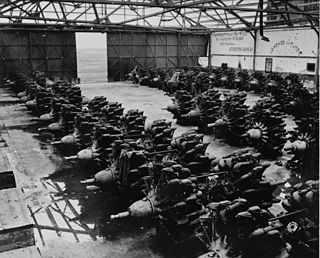
The Gnome-Rhône 14K Mistral Major was a 14-cylinder, two-row, air-cooled radial engine. It was Gnome-Rhône's major aircraft engine prior to World War II, and matured into a highly sought-after design that would see licensed production throughout Europe and Japan. Thousands of Mistral Major engines were produced, used on a wide variety of aircraft.
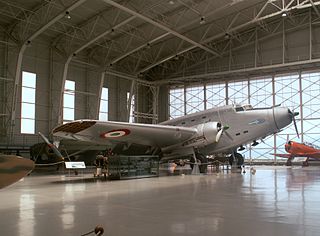
The Savoia-Marchetti SM.82 was an Italian bomber and transport aircraft of World War II. It was a cantilever, mid-wing monoplane trimotor with a retractable, tailwheel undercarriage. There were 875 built, the first entering service in 1940. Although able to operate as a bomber with a maximum bombload of up to 8,818 lb (4000 kg), the SM.82 saw very limited use in this role. The SM.82 was the foreign aircraft used in largest number by the Luftwaffe, which operated several hundreds of this aircraft, as a transport. Post-war about 30 SM.82s continued in service with the Aeronautica Militare Italiana, many remaining in service until the early 1960s.

The Gavilán 358 is a Colombian light utility transport aircraft of the 1990s. A high-winged monoplane powered by a piston engine, small numbers of Gaviláns were produced in the late 1990s/early 2000s, some serving with the Colombian Air Force.

The Savoia-Marchetti SM.85 was an Italian monoplane dive bomber and ground-attack aircraft that served in small numbers in the Regia Aeronautica at the beginning of World War II. They were soon replaced in service by the Junkers Ju 87.

The Savoia-Marchetti SM.84, not to be confused with the Savoia-Marchetti S.84 airliner prototype, was an Italian bomber aircraft of World War II. It was designed by Savoia-Marchetti as a replacement for its successful SM.79, and shared its three-engine layout. Despite entering service with the Regia Aeronautica in 1941, it was retired from service before the SM.79 and never fully replaced it.

The Savoia-Marchetti SM.89 was an attack aircraft designed by Alessandro Marchetti and built by Savoia-Marchetti. Only one example was built, the prototype (MM.543).
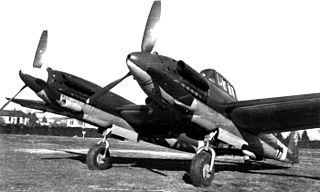
The Savoia-Marchetti SM.92 was an Italian heavy fighter/bomber of World War II based on the Savoia-Marchetti SM.88. The SM.92 did away with the mid-wing crew nacelle. The crew of two sat in the left fuselage only. Two DB 605 engines were fitted.

The Savoia-Marchetti SM.62 was an Italian single-engine maritime patrol flying boat produced from 1926. It served with the Regia Aeronautica and with a number of foreign users, and was licence-produced in Spain and the Soviet Union. Some of the Spanish aircraft were still in service during the Spanish Civil War
The Piaggio P.32 was an Italian medium bomber of the late 1930s, produced by Piaggio, and designed by Giovanni Pegna. It was a modern design for its time, but was a failure due to lack of powerplants commensurate with its high wing loading.
The SIAI-Marchetti SM.101 was a 1940s Italian single-engined light transport cabin monoplane designed and built by SIAI-Marchetti.
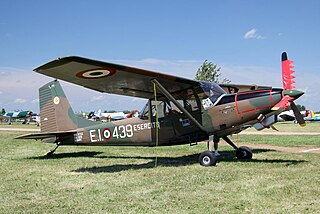
The SIAI-Marchetti SM.1019 is an Italian STOL liaison monoplane built by SIAI-Marchetti for the Italian Army, and based on the Cessna O-1 Bird Dog.

The PZL SM-2 was a Polish light utility helicopter, enlarged version of license-built Mil Mi-1, developed and produced by WSK PZL-Świdnik. It was also known as the WSK SM-2.
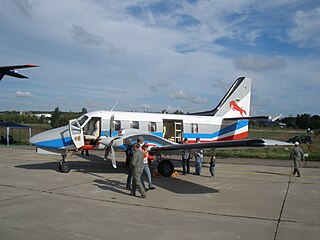
The Technoavia Rysachok is a general purpose, twin turboprop-powered engined light utility aircraft, designed and built in Russia by Technoavia. Certification was expected by 2012 and by autumn 2011 three flight pre-production examples had been completed and flown. As of 2015 the certification process is stalled and Technoavia has declared that it is no longer involved in the project.



















